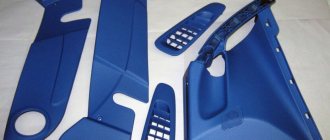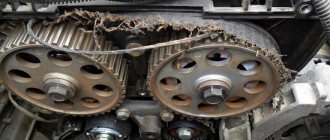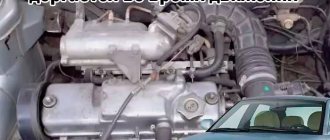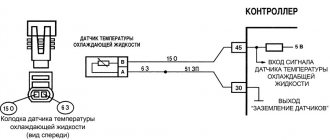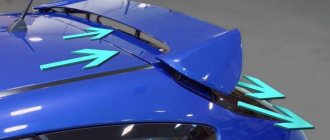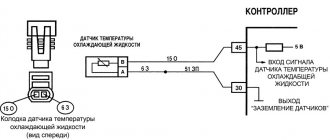Welcome to the kuzov.info blog!
In this article we will look at several ways to remove smudges after painting a car.
Smudges occur due to applying the second coat too early. Other reasons: paint or varnish diluted too thin, incorrect spray technique (spray gun too close, spray speed too slow), temperature in the paint room too low. You can read about how to paint without streaks here.
Not all stains can be removed; sometimes it is better to prepare the surface again and repaint.
To remove smudges, the market for body repair products offers special cutters (English: to cut), sanding blocks, micro-cutters, as well as special plates (shim masks) that isolate the paint coating surrounding the smudge from the effects of abrasive materials during smudge removal. All these products are quite common, but have a considerable cost. We will look at more affordable options for eliminating smudges during and after painting.
Why does the soil fall on Shagreen?
There are many reasons for the appearance of incorrect shagreen: - Incorrectly diluted material. The paint is too thin or thick. — The spray gun is faulty.
Interesting materials:
When is the best time to go to Spain? When is the best time to go to Korea? When is the best time to eat fruit? When is the best time to swim at Epiphany? When is the best time to fly to Cyprus with children? When is the best time to replant thuja? When is the best time to buy airline tickets? When is the best time to take casein? When is the best time to harvest nettles? When is information best received?
How to remove smudges before the paintwork hardens?
- Never try to wipe away a smudge with a rag or napkin, as this may disturb the underlying layers of paint.
- You can reduce the spread and increase of smudges during painting. If you notice that a leak is beginning to form, you can stop its formation by blowing a gentle stream of compressed air over the area. This will speed up the evaporation of the solvent, stop the leakage and make it easier to remove it after hardening.
- For fresh, uncured smudges, the following method works: take masking tape and touch the sticky side to the top of the smudge. Some of the flowing varnish will transfer to the tape. This can be done several times, each time touching with the clean sticky side, until the bulk of the smudge is removed. You just need to lightly touch without touching the lower layers of paint. Next, blow this area with compressed air from a spray gun to speed up the evaporation of the solvent, spray a dry thin layer of varnish and leave to dry. After 15–30 minutes, apply a full coat of varnish (see article on proper varnishing). The remaining irregularities can be removed by sanding after the paintwork has completely hardened.
- If a smudge has formed during painting, it can be moved lower by spraying an excess amount of varnish into the smudge area. Thus, you can move the smudge to a place where it will be easier to remove it (for example, away from the edge or concave part) or even beyond the edge of the panel. This method works on vertical body panels.
Fresh varnish smudge on a car fender
You need to spray an excess amount of varnish into the smudge area.
The leak begins to slide down
As a result, the smudge disappeared and the paintwork became smooth.
The varnish leak has moved down the wing
Elimination methods
To combat this evil, sandpapers with small grain sizes were invented: 1500, 2000, 2500. Although they leave small scratches on the paintwork, they can then be easily removed with polish. First rough, then softer. Sanding is a monotonous and lengthy process. The temptation to take a larger skin will result in damage to the paintwork. You can carefully remove this tubercle with a special plane. But the risk of harm is also great.
There are several ways to remove shagreen after painting with your own hands. Shagreen in itself is not dangerous. She's just plain ugly. Thorough polishing cannot always remove it. You should lightly walk over the defective surface with fine sandpaper. If the defect is not significant, this will help. An overly expressive “image” is completely removed and the area is repainted.
There are ways to eliminate this defect. To do this, lightly sand the surface with very fine sandpaper and water. You need to add a drop of Fairy substance to the water. But it is better to remove the paint and repaint it again.
Polishing a car after painting the body
Polishing a car after painting
After polishing the car, to maintain the shine and good appearance after painting the car for a long time, you need to polish the car body. Polishing a car body is designed to give the car an excellent appearance, eliminate microcracks, scratches, remove the smallest unevenness in the coating and protect the coating from external factors. Since the smallest paint defects, invisible to the naked eye, allow aggressive liquids to penetrate under the coating and cause corrosion, polishing also protects the body from these processes. Polishing stages:
- partial removal of the coating, in which fine abrasive sandpaper is used;
- restorative polishing using abrasive paste;
- protective polishing after painting the car with a non-abrasive paste to give a special shine.
Types of polishes
- If the paint on the body is not badly damaged, then it is enough to use a polish without abrasive particles to restore it, but before that you need to treat it with a polish with a high content of abrasive elements.
- If there are a large number of microcracks on the body, it is better to use color-enriching polishes. Which cannot replace paint and eliminate scratches to metal, and they do not form a protective coating on the body, so they should be used in combination with protective types of polishes.
Classification of polishes by consistency:
- paste polishes. They are used for horizontal and vertical surfaces due to their thick consistency. At the same time, they give the coating a significant depth of color;
- Liquid polishes are safer to use because they do not cause increased wear of the coating even with prolonged use. But they are limited in scope and are used only on horizontal surfaces;
- Although aerosol polishes are convenient to use, due to the fact that a significant part of the can is occupied by solvent and propellant, the amount of polish itself in it is not very large.
Depending on the depth of damage to the body coating after painting a car, polishing is divided into restorative and protective.
Car polishes
Restorative polishing can be used to remove shallow scratches, the depth of which does not exceed the depth of the paintwork before the primer; tearing out abrasions and oxidized layers, which manifest themselves as clouding of the paintwork, in the form of spots or stripes. The process of applying restorative polishing consists of mechanically removing a surface layer with abrasive pastes about 5 microns thick. Whereas the thickness of the paint coating is about 100-150 microns, therefore about 10-20 polishings can be carried out on one painting without compromising its integrity. Protective polishing is designed to protect the paintwork after painting a car from negative environmental influences. It uses non-abrasive polishes based on wax or synthetic materials. Depending on the bases on which polishes are made, they are divided into wax, silicone and polymer. Wax and silicone protective polishes are easy to apply, but also easy to wash off after two or three visits to the sink. And they will need to be reapplied. Polymer polishes are more durable; they are applied once every 6 months, have good protective properties, but at the same time they are more expensive and their application is more labor-intensive. If you painted your car metallic or pearlescent, then you need to buy polishes specifically for these types of coatings.
Causes of leaks:
- Incorrect paint viscosity when spraying
- Incorrect technique for applying paint or varnish. Uneven, intermittent or too slow movement of the spray gun can cause smudges to form. Incorrect overlap of previous spray pass. Typically, the next spray pass should cover 50% of the previous spray pass.
- The nozzle on the varnish spray gun is too large
- Incorrect gun settings. The pressure should not be too much. The thinner the paint or varnish, the lower the paint or varnish flow on the spray gun should be set.
- Insufficient drying time between coats. This is an important point!
- Incorrect temperature of paint and surface to be painted.
- Low temperature and high humidity in the room where painting is done. The thinner does not have time to evaporate.
- Incorrect choice of hardener and thinner. At low temperatures, a “slow” thinner will be inappropriate.
- The distance of the spray gun from the surface to be painted is too close
- Applying one thick coat of paint or varnish instead of several thin ones. Especially when applying paint or varnish diluted in liquid. A thick layer is heavy and begins to flow under the influence of gravity.
- Poor surface preparation.
Defects in car paintwork
Painting and subsequent varnishing of a car may not always work out. This process requires maximum concentration from the person performing the work, adherence to technology and the use of decent quality materials. But even professional work is not without unpleasant surprises. Moreover, it is much easier to prevent various kinds of errors than to remove them later.
One of the common defects is smudges - drop-shaped formations that appear on the body.
Main causes:
- Unfavorable external conditions. Varnishing can take place in a cold structure or with cold materials. Therefore, it is necessary to warm up the room and the car itself.
- Features of materials. The use of varnish and thinner must be in the correct proportion. They must also be suitable for each other, so it is better to use paints and varnishes from the same manufacturer.
- Inaccurate spray adjustment. The enamel must be fed through a well-functioning small hole in the spray gun, maintaining an angle of 90 degrees. If you use a large nozzle, the varnish will flow rather than spray, and droplets will remain on the body.
- Insufficient degreasing of the car before applying enamel.
Incorrect positioning of the spray gun is the cause of smudges
Elimination of varnishing errors
There are several ways to remove smudges.
The first method is “washing out”. You will need putty, fine sandpaper (P2500 and P2000), water and a vacuum cleaner. The car surface to be treated is first thoroughly dried (an industrial hair dryer or spotlight can speed up the process). Then putty is applied to the stains - it will protect the varnish from damage.
The putty layer is watered and then carefully polished with sandpaper (P2500). By the way, if you wrap it around an even block and make short movements, the polishing will be done more accurately. After reaching the thickness of the putty layer, you should take a finer sandpaper (P2000) and treat the surface with it until the putty disappears. After this, polishing is completed with P2500 sandpaper. At the end of the work, you need to remove the dust with a vacuum cleaner and (if desired) re-coat the sanded fragment with a layer of varnish.
The second method is “washing out” with a marker. You will need a marker, fine sandpaper, water and a vacuum cleaner. This method is similar to the first, the only difference is that the marker replaces the putty. By drawing lines with a marker on the smudges, you can see how deep the polishing goes.
The third method is scraping. You will need masking tape, a construction knife, a rubber block, several types of sandpaper P600-P2500, soap, water. The area where the car is sagging is covered with masking tape. It is needed so as not to damage the clean surface. The smudges themselves should not be soft. Just in case, you can dry them.
Removal of smudges is done with a knife blade - they are carefully scraped off from top to bottom. Then, with a rubber block wrapped in coarse sandpaper and soaked in a soap solution, those places on the car where the varnish was scraped off are sanded. Gradually, the sandpaper needs to be changed to a finer one, ending at P2500.
The fourth method is removal with a cutter. Its main purpose is to remove dust, but it also copes well with influx. The cutter should be held at an angle of no more than 40 degrees. After treatment, the leak area is carefully sanded.
Thus, even with simple improvised means you can remove defects in car varnishing. The main thing is attentiveness and accuracy.
How to pay TWICE LESS for GASOLINE
- Gasoline prices are rising every day, and the car's appetite is only increasing.
- You would be happy to cut costs, but is it possible to live without a car these days!?
Available means
After finishing painting, it is recommended to remove smudges on the car only after the first layer of paint has completely hardened.
If you rush and start the process earlier, you risk starting the process all over again. Before eliminating defects, prepare tools and other materials:
- Soap solution.
- A well-sharpened knife or blade.
- Scotch tape, preferably using masking tape.
- Sanding paper of different grits.
- Beam.
- Apparatus for polishing work.
- Napkins or piece of cloth.
Soap solution
During the application of paint and varnish, agents are also used to protect the body. Gloves, goggles and a respirator are usually worn.
Secrets of excellent results
- Lighting. Paint in daylight. You should be able to clearly see the painted areas and their boundaries.
- Humidity. The humidity level in the room should be above average (45%). That is why painting work carried out in the summer gives better results. In winter, the air in the room is very dry, which speeds up the drying of the paint. You simply won’t have time to distribute it over the entire area. During the cold season, it would be advisable to use a humidifier.
- Order. Agree that painting walls and ceilings when you always have to step over something is uncomfortable. Before finishing work, you should remove all objects from the room, or, in extreme cases, move them to the middle of the room. Instead of a stepladder, use a roller extension, this way you won’t waste time going up and down, and you won’t have to lift your head too much when working with the ceiling.
- Paint consistency. Be sure to dilute the paint with water or thinner and mix well so that it is uniform. It happens that a film forms on oil paint. In this case, it must be filtered through tulle fabric or nylon stocking.
- Roller squeezing. The painting cuvette has one wall located at an angle and covered with protrusions. This is necessary to evenly distribute the paint over the coat of the roller, and not for squeezing. The roller should not be dry. Dip it in paint and “walk” without pressing along the ribbed slope. The paint will be distributed throughout the coat, and its excess will flow into the ditch.
- Zeal. When moving the roller along the work surface, you do not need to put pressure on it. It should roll easily.
- Coating. As noted, paint over large areas should be applied not in stripes, but in W-shaped movements. Divide the area into squares and paint each one in turn. We made a zigzag, distributed the coating over the square and moved on to the next one. We rolled out the boundaries of the plots and moved on. And paint drips will not appear. If you are painting walls that have been previously plastered, spread the paint in a vertical motion. In log rooms, paint is rolled out horizontally - in the direction of the wood fibers.
- Control inspection. The surface must be inspected immediately after painting. To make possible imperfections more visible, illuminate yourself with a bright flashlight. If there are unpainted areas, roll them immediately.
What to do with old stains
There are long-term stains that appear from long-standing leaks and are not eliminated. No matter how much you make repairs, they will show through the paint again and again.
To remove these unsightly places, they should be thoroughly cleaned and washed. Then the problem areas need to be treated with any biocidal solution (a means for destroying fungus, mold, etc.). There is no need to rinse off the solution!
Be sure to wait until it is completely dry to ensure that re-cleaning is not necessary.
Next, a blocking primer is applied to the areas. It is waterproof and will reliably protect your walls and ceiling from stains and smudges. After drying, you can begin painting.
Eliminating smudges on hardened paint
In this case, unfortunately, you will have to put in more effort than in the previous one. If you find a smudge on hardened paint, do not panic; it can be removed without completely repainting a certain element.
Important! If the paint has not yet completely hardened, but is already close to it (that is, it will not spread on its own if tilted correctly), do nothing! Let it cool completely! Otherwise, you risk removing several layers of paintwork at once, and then you will probably have to repaint everything again.
Elimination of such “errors” should be done in the following order:
- First, mark the boundaries of the defect (so that during subsequent work you do not “do extra work”).
- Use a blade to cut off the leak. Let us remind you that you need to do this work as carefully as possible (try to feel like a jeweler at this moment). Start removing drops from the top, slowly moving down.
- The third stage is the skin (by the way, it can also be the second, but only if the defect is very small). So, install a P800 sandpaper on the grinding machine, using a special cream (sometimes it is replaced with plain water). The closer you come to “victory”, the end of the work, the more often you replace the skin with a softer one. The work should be completed with P200. Be especially careful, do not rush and remember that it is much better not to rub it in than vice versa.
- Polishing is carried out precisely at this stage. But at the same time, constantly move the grinder, never staying in one place.
How to paint edges without drips?
I'll give an example of what I do. This is a proven method and I practically never have any drips, except when they are permissible (on the ground).
Let's imagine that we have set up the spray gun, filled it with primer and are about to cover the door leaf.
Often inexperienced Painters begin to cover the horizontal plane first, and then the edges...
What's bad about it ?
Yes, nothing bad, only on a horizontal plane you apply layer after layer, you can make it thicker and thicker even with a slide :), but on the edges this doesn’t work, gravity, mass of bodies and all that...
What you need for work
When choosing a method for removing paint and varnish stains, evaluate the surface area and the reason for the formation of drops.
Grinding the surface of a car to remove varnish smudges
Next, determine the list of materials needed for the work, which include:
- soapy water;
- masking tape;
- sharpened blade (for a razor or wallpaper knife);
- sandpaper of various brands: P600, P1000, P1500, P2500;
- a block of wood or rubber.
- polishing paste;
- grinding machine;
- universal putty;
- rag or napkin.
You will also need personal protective equipment: glasses, respirator mask, gloves.
How to paint with acrylic paints correctly?
Before applying paint, it should be evenly distributed over the entire surface of the instrument, “rolled” on a special tray in a shallow puddle of paint until the sponge or fur wrap is completely saturated. Then press down lightly and roll along the plane, squeezing out the excess. Ideally, the layer should lie smoothly, without drips.
Interesting materials:
Who monitors compliance by cadastral engineers with the requirements under the compulsory civil liability insurance agreement for a cadastral engineer? Who provides compensation for moral damage to the insured? Who discovered the strait separating Asia from America? Who discovered North America? What was Yesenin's education? Who was Oblomov by origin? How are the husbands of two sisters related to each other? How are cousins' wives related to each other? Who was Peter III related to Elizabeth Petrovna? How is my brother's wife related to my husband?
Removing smudges: preparation and consumables
Cut off the stains with a blade
Paint stains must be removed before applying the final varnish coating. To get rid of defects that spoil the appearance of your car that appear after a not very successful painting, you need to have on hand:
- Masking tape is always required when painting;
- a set of skins of different grain sizes (usually P800 and fine P2000 are used);
- soap solution or just water;
- a rubber or wooden block, which we wrap in sandpaper;
- thin and sharp blade;
- universal putty;
- polishing paste;
- polishing machine;
- wipers and a wiper brush (to remove dust generated during sanding).
Types of aerosol paints
Applying paint by pressing the spray button is almost a fun activity, until the paint starts to flow on the surface. When working with a brush, application is controlled, but in the case of spray cans, there is no direct contact of the tool with the surface. In order not to spoil the entire surface with inept actions, it is worth understanding what types of paints are available in spray cans and what they are most suitable for:
- Aerosol varnish – suitable for painting furniture, can be used either independently or as an application to an already painted surface;
- Aerosol enamel - used for painting metal products - cabinets, motorcycles and automotive equipment;
- Aerosol paint for plastic surfaces - you can use it to paint garden plastic furniture and car parts;
- Matte spray paint – can be used on any type of surface;
- Heat-resistant spray paint - used for painting parts that can heat up to 650 degrees C;
- Decorative paints are designed to create various decorative effects.
Other things to consider
Flaws are best shown in white. To protect yourself from possible failure, do not take a snow-white coating or add a little color to it.
To paint the walls, take the paint that you like best. For the ceiling, take the highest quality one. The ceiling is the most finicky of all planes, especially since you cannot cover the flaws on it with furniture or paintings.
The main components of an excellent result: a well-prepared base, a non-viscous coating and adherence to painting technology. But at the same time, know that the ideal does not exist, which means you shouldn’t squeeze all the juice out of yourself to achieve it.
